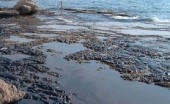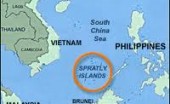Re Ian Bremmer 'Could third-party candidates upend the 2024 US election?' 3 April The current political movement in the USA…
Gulf of Mexico Oil Spill Aftermath
Written by Diana Thebaud Nicholson // June 24, 2019 // Oil & gas // Comments Off on Gulf of Mexico Oil Spill Aftermath
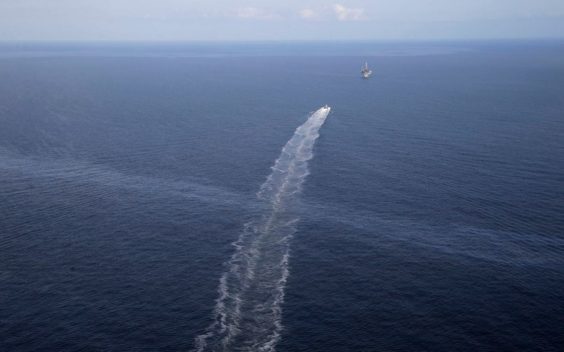 A supply vessel crosses over oil drifting from the site of the former Taylor Energy rig off the coast of Louisiana on March 31, 2015. The Coast Guard said this year that a newly installed containment system is collecting oil at the site, nearly 15 years after the leak began. (Gerald Herbert/AP)
A supply vessel crosses over oil drifting from the site of the former Taylor Energy rig off the coast of Louisiana on March 31, 2015. The Coast Guard said this year that a newly installed containment system is collecting oil at the site, nearly 15 years after the leak began. (Gerald Herbert/AP)
The U.S. government has studied the longest oil spill in history — 14 years after the leak began
(WaPo) The federal government’s first study of the nearly 15-year-long oil spill in the Gulf of Mexico estimates that up to 108 barrels per day — more than 4,500 gallons — is flowing from a site where an oil company’s platform and wells were destroyed during a hurricane. Monday’s report, by two scientists at the National Oceanic and Atmospheric Administration and a Florida State University professor, joined several others in disputing the company’s claim that only one drop of oil per minute is being released from a small area covered in mud, amounting to less than three gallons each day.
“The results of this study contradict these conclusions by the Taylor Energy Company,” the authors said. The government’s findings also differ from those of three studies last year that said the flow of oil from the site was substantially higher.
Geoscientist Oscar Garcia-Pineda estimated that between 250 and 700 barrels per day — up to 29,000 gallons — are flowing into the gulf. University of South Florida marine scientist Shaojie Sun determined that between 50 and 1,700 barrels per day — up to 71,400 gallons — were pouring from the site.
Even one of the federal report’s authors — Ian MacDonald, the Florida State professor — estimated that nearly 150 barrels, about 6,300 gallons, spilled from the site that Taylor Energy once leased in an underwater canyon 12 miles off the coast of Louisiana. The other authors were NOAA scientists Andrew L. Mason and J. Christopher Taylor.
2 May
Trump administration to ease safety rules created after deadly Deepwater Horizon explosion
(AP) — The Trump administration on Thursday moved to ease safety regulations adopted after the 2010 BP Deepwater Horizon blowout, the worst offshore oil disaster in U.S. history that killed nearly a dozen people.
Interior Secretary David Bernhardt said in a statement the administration was acting to eliminate “unnecessary regulatory burdens while maintaining safety and environmental protection offshore.” The oil industry has been challenging the Obama-era rules, which govern the operation of offshore wells.
A bipartisan investigatory commission appointed by the Obama administration pointed to crew and technical failures in the explosion, but cited overall safety shortcomings by regulators and the oil industry. “The most significant failure … and the clear root cause of the blowout — was a failure of industry management,” the investigation panel concluded.
The easing of some of the Obama-era safety measures come as the Trump administration pushes to greatly expand drilling off the country’s coasts, although court challenges and opposition from many coastal states has slowed the effort.
Environmental groups fiercely oppose the rule changes, which become effective 60 days after publication in the Federal Register.
2018
16 January
BP’s Deepwater Horizon bill tops $65bn
Firm’s financial pain offset by rising oil prices as it winds down payouts from 2010 disaster
(The Guardian) BP is nearing the end of the $65bn (£47bn) Deepwater Horizon compensation process, it said as it announced an unexpectedly high payout of $1.7bn among the final few hundred outstanding claims. The British oil firm said on Tuesday it would pay the $1.7bn charge in the last quarter of 2017 for court-ordered payments resulting from the worst oil spill in US history. It means BP will have paid out $3bn in compensation for 2017, compared with the $2bn anticipated.
The jump in spill-related costs is a reminder of how difficult it has been for the company to draw a line under Deepwater, eight years on from the Gulf of Mexico disaster, which affected everyone from fishermen to people working in tourism.
2015
20 May
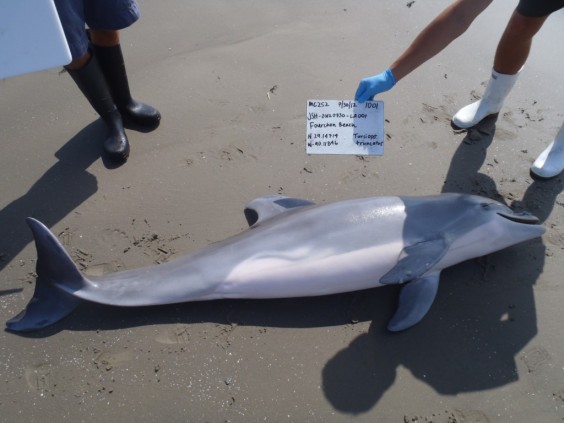 New science shows Gulf spill is still killing dolphins
New science shows Gulf spill is still killing dolphins
(PBS Newshour) More than 1,000 bottlenose dolphins have died off the Gulf Coast since 2010, the year a massive Deepwater Horizon spill spewed millions of gallons of oil and chemicals. A new study by researchers at the National Oceanic and Atmospheric Administration examines why.
NOAA Report: Deepwater Horizon oil spill caused biggest dolphin die-off in Gulf’s history today’s study announces a firm connection between the petroleum exposure caused by the Deepwater accident and the ongoing UME — the biggest in the recorded history of the Gulf. Prior to the Deepwater incident, the longest recorded UME had lasted 17 months from 2005 to 2006, while the most fatal occurred in 1990 — claiming 344 bottlenose dolphins.The researchers argue that when the dolphins swam to the surface for air, oil fumes and liquid petroleum leaked through their blowhole into the lungs and caused disease. The mortal blow for most of these marine mammals came in the form of shrunken, thinner adrenal glands, which had never been previously observed in Gulf dolphins.
The ongoing die-off has claimed three times as many animals and lasted 60 months.
2014
8 December
U.S. Supreme Court rejects BP challenge to Gulf spill settlement
The U.S. Supreme Court on Monday rejected BP’s challenge to its multibillion-dollar settlement agreement over the 2010 Gulf of Mexico oil spill, which the oil giant complained has allowed certain businesses to get payouts despite being unable to trace their losses to the disaster.
The court’s decision not to hear the London-based company’s appeal is the latest setback for BP, which is trying to limit payments over a disaster that killed 11 people and triggered the largest U.S. offshore oil spill.
10 September
The Gulf Is Still So Far From Recovering. Just Ask This Oyster Farmer.
Gulf coast ecosystems were supposed to rebound after the BP oil spill. They haven’t.
(Mother Jones) Official state data shows that while the statewide oyster harvest did rebound following the spill, it has since been roughly 23 percent lower on average than prior to the spill. …
The catastrophe was not limited to oysters. With untold millions of barrels of oil spilled into the gulf (a federal court in New Orleans is set to rule on the exact volume in January), the ecological fallout was swift and severe, affecting everything from deep-water invertebrates at the foundation of the food chain to tuna to cetaceans (whales and dolphins). New evidence is emerging that links an ongoing, severe die-off in the gulf—more than 1,000 cetaceans have washed ashore dead since the event began in spring 2010, with scientists scrambling to understand why—to oil pollution.
29 July
BP Oil Spill Is Much Worse Than People Think, Scientists Say
(ThinkProgress) Scientists at Penn State University have discovered two new coral reefs near the site of BP’s historic 2010 oil spill in the Gulf of Mexico, and the impacts to those reefs from the spill have been greater than expected, according to research released Monday.
The two additional reefs found by the PSU team were both farther away and deeper than the one coral reef that had previously been found to have been impacted by the spill. That indicates not only that marine ecosystems may be more greatly affected, but that some of the 210 million gallons of oil that BP spilled into the Gulf is making its mark in the deep sea.
“The footprint of the impact of the spill on coral communities is both deeper and wider than previous data indicated,” PSU biology professor Charles Fisher, who led the study, said.
2013
1 October
BP ‘lied’ over true extent of its Gulf oil disaster
Second phase of trial opens with claims of negligence and lack of preparation
(The Independent) BP last night stood accused of telling “outright lies” and withholding crucial evidence about the amount of oil flowing from the damaged Macondo well in the Gulf of Mexico when it blew open in 2010.
As the second phase of the trial into the disaster opened in New Orleans, and with billions of dollars of potential fines in the balance, the oil giant’s lawyer, Mike Brock, said the company had done everything it could to cap the gushing well that was exposed following an explosion on the Deepwater Horizon rig that led to the deaths of 11 workers.
But Brian Barr, a lawyer for the plaintiffs, said BP had failed to prepare for such an accident. In his opening statement, Mr Barr also said the evidence “will show BP’s outright lies caused the oil to flow” for 87 days. A lawyer for Transocean, the owner of the rig, also said BP had repeatedly withheld evidence about the rate at which oil was flowing. More on The Guardian
19 September
Halliburton pleads guilty to destroying Gulf spill evidence
(Planet Ark) Halliburton Co pleaded guilty on Thursday to federal charges of destroying evidence, stemming from its role in the 2010 BP oil disaster that killed 11 men and sent more than 4 million barrels of oil spewing into the Gulf of Mexico.
A former Halliburton cementing technology director in Texas also was charged on Thursday with destroying evidence.
U.S. District Judge Jane Triche Milazzo in New Orleans accepted the company’s guilty plea from Halliburton legal counsel Marc Mukasey, imposed the agreed-upon maximum fine of $200,000 and placed the company on a three-year probation term.
26 July
Halliburton Admits It Destroyed Evidence to Make Itself Look Better During the BP Spill
(Slate) Halliburton has admitted that it destroyed evidence during the 2010 Deepwater Horizon oil spill disaster, a criminal act designed to keep the blame—and the government’s anger—squarely focused on BP and Transocean as an estimated 5 million barrels of crude oil leaked into the Gulf of Mexico. The surprising admission will bring with it a guilty plea to one count of criminal conduct, a $200,000 statutory fine, and three years probation for the oil services giant, the Justice Department announced Thursday evening.
A quick refresher on Halliburton’s role on what turned out to be the infamous oil rig: The Houston-based company provided the cement that was supposed to seal the spaces on the outside of the well’s steel drilling pipe. The quality of that concrete, and the process in which it was installed, received a decent amount of scrutiny from lawmakers and independent investigators at the time—but likely would have gotten a whole lot more if it weren’t for the attention paid to the metal collars that were used to help stabilize the drill pipe in the center of the hole. …
The $200,000 fine is, obviously, unlikely to make a noticeable mark on Halliburton’s balance sheet. But the admission of wrongdoing—along with the confirmation that BP’s centralizer decision likely played a smaller role than once thought—will make it that much more difficult for Halliburton to avoid paying out large sums to settle civil suits.
27 February
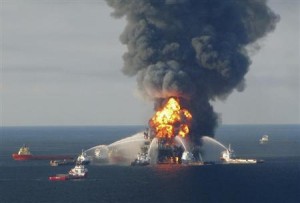 First spill trial witness: BP put cost cuts over safety
First spill trial witness: BP put cost cuts over safety
(Planet Ark) BP Plc fostered a culture that put cost-cutting over safety before the deadly 2010 Gulf of Mexico oil spill, a noted forensic engineer said in the first day of testimony in the federal civil trial centered on the disaster.
“There is ample evidence of intense pressure within the system to save time and money,” said Bob Bea, co-founder of the Center for Catastrophic Risk Management at the University of California, Berkeley. “With stress and pressure come sacrifices to safety.”
Bea was the first witness for the plaintiffs, the U.S. Justice Department and U.S. Gulf Coast states suing Macondo well owner BP, rig owner Transocean Ltd and well cement provider Halliburton Co.
The plaintiffs plan to call Lamar McKay, chairman and president of BP America, to testify as a hostile witness once Bea wraps up. McKay is a member of the London-based oil company’s executive committee, alongside Chief Executive Officer Bob Dudley.
2012
BP settlement not the final word in spill story
(CNNMoney) — BP announced Thursday it settled criminal charges with the U.S. government over the 2010 Deepwater Horizon oil spill for $4.5 billion. But that won’t resolve some of the biggest liabilities still facing the company.
Chief among them is the penalty that could come out of the Clean Water Act — a potential civil fine for spilling the oil itself.
If things go the company’s way, that fine could be somewhere between $3.5 billion and $5 billion, said Jason Gammel, an analyst at Maquarie Securities Group in London.
But if BP is found guilty of gross negligence in the spill, the penalty could more than quadruple to roughly $20 billion — dwarfing today’s settlement.
The government has accused BP of gross negligence in the spill. A civil trial is set for February, and could drag on for years.
BBC points out BP launched an internal investigation in the immediate aftermath of the explosion which concluded that no single cause was behind the accident, but “multiple companies, work teams and circumstances were involved over time”.
Other companies involved included Transocean, the owner of the rig and responsible for the safety valve known as the blowout preventer, and Halliburton, who provided cementing services.
BP is yet to reach a settlement with these firms. A civil trial that will determine negligence is due to begin in New Orleans in February 2013.
BP’s Deepwater settlement considered chump change by critics
(LA Times) British oil giant BP is more than prepared for the $4.5 billion in settlement charges it agreed to Thursday, analysts said.
BP agreed to plead guilty to 11 felony counts of misconduct or neglect of ships officers directly related to the 2010 Deepwater Horizon explosion in the Gulf of Mexico that killed 11 workers.
BP also agreed to one misdemeanor count under the Clean Water Act; one misdemeanor count under the Migratory Bird Treaty Act; and one felony count of obstruction of Congress. The deal requires U.S. federal court approval.
In the third quarter alone, BP raked in sales of more than $93 billion and had a net profit of more than $5.2 billion. That was a result that showed that “BP has made the most remarkable comeback from the most costly industrial accident in history,” said Fadel Gheit, senior energy analyst at Oppenheimer and Co., in a note to investors.
12 September
Storm Isaac tars Louisiana beaches with oil from BP spill
(Planet Ark) Two years after the worst offshore oil spill in U.S. history, mats of oily tar from BP Plc.’s ill-fated Macondo well have turned up on Louisiana’s shore after Hurricane Isaac stirred up submerged oil deposits, BP officials said on Tuesday.
17 June
Study: BP Gulf of Mexico oil spill could still be damaging fish
Oil residue from the 2010 BP oil spill in the Gulf of Mexico could be causing potentially lethal defects in fish, according to a Smith College biologist.
“This oil is not gone yet. This disaster is not over. There are embryos right now that are still getting exposed to that oil,” said Michael J.F. Barresi, who, along with students at Smith College and the University of Massachusetts, conducted a study of the effects of oil residue of the type and in the concentrations that existed in the Gulf after the spill.
An article about the study and their findings appeared in a recent issue of BMC Biology, an online journal. Barresi was the lead investigator.
27 April
Aftermath: The Deepwater Horizon, Two Years on
(Bloomberg) More than two years later, the legal aftermath of the accident is taking shape. Just this week federal authorities indicted a BP engineer on obstruction of justice. Separately, a federal judge in New Orleans indicated he was “leaning” toward preliminary approval of a $7.8 billion settlement between BP and private plaintiffs. The U.S. Department of Justice investigation into the spill, and possible Clean Water Act violations related to it, continues.
19 April
Deepwater Horizon aftermath: how much is a dolphin worth?
(Guardian)Two years after the Gulf of Mexico oil disaster, BP and US authorities wrangle over how much should be paid in damages
18 March
BP oil spill settlement: Justice for 100,000 Gulf Coast victims?
(CSM) The estimated total cost of the settlement will be about $7.8 billion, which makes it one of the largest class-action settlements in US history. The BP oil spill settlement was filed Wednesday.
Two days before the two-year commemoration of the start of the Gulf of Mexico oil spill, BP and a committee representing more than 100,000 plaintiffs have agreed on a blueprint to settle billions of dollars in unresolved economic, property, and medical damage claims.
6 March
Is the US Gulf oil spill issue truly settled?
British oil giant BP has agreed to compensate thousands of victims but many key issues remain unresolved.
(Al Jazeera) Late last week, the British oil giant BP agreed to pay out an estimated $7.8bn to settle a lawsuit with more than 120,000 victims of the disaster.
A trial to determine blame has been postponed. But settlements will not be universally welcomed around the Gulf. Many still want to see BP, Transocean and Halliburton held to account in court.
And, whatever the outcome some important issues still remain unanswered.
Firstly, the health impact of the chemical dispersants – more than eight million litres – that were used to break up the oil spill is still unknown.
Secondly, there is the environmental damage. While the oil may have visibly cleared from the Gulf, it may be years before ecologists know the full impact of the spill. …
What BP’s settlement entails:
It gives affected individuals and businesses an estimated $7.8bn but that is not the end to BP’s legal woes. The agreement does not include BP’s partners Transocean, which owned the doomed Deepwater Horizon oil rig, or Halliburton, which provided the rig with construction materials. The two companies also face possible criminal and civil penalties with an estimated $65bn in long-term cleanup costs.
Those seeking damages from BP and its partners include their investors, the US federal and state governments, and workers who helped clean up the spill. Also, BP, Halliburton and Transocean are suing each other.
3 January
BP asks Halliburton to pay for Gulf of Mexico spill
(BBC) Oil giant BP has asked its contractor Halliburton to pay for all costs and damages that arose from the oil spill in the Gulf of Mexico.
The claims were made in a filing by BP’s lawyer Don Haycraft in a US Federal court.
BP and Halliburton are locked in a legal battle with a trial expected this year to settle damages claims.
2011
16 November
BP gulf spill has not dimmed Tony Hayward’s ambition
(The Guardian) Former BP boss is glad to be back in the oil business – this time in Kurdistan – but is not saying what Deepwater Horizon taught him
6 December
Halliburton ‘destroyed’ evidence after Gulf oil spill, BP charges
(CSM) BP alleges that Halliburton, a subcontractor working on the Deepwater Horizon rig, destroyed evidence pertaining to what might have caused the explosion that triggered the Gulf oil spill.
The allegation by oil giant BP that Halliburton, a subcontractor on the doomed Deepwater Horizon drilling rig, destroyed data about a cement slurry operation is a glimpse into a nasty corporate court battle set to go to trial in federal court in New Orleans in February.
16 September
Analysis: BP oil spill report may prompt $30 billion pay-out
(Reuters) – Findings of the second major investigation by the government into the 2010 Gulf of Mexico oil spill, may press BP into putting over $30 billion on the table to quickly settle its outstanding legal headaches.
The report, released on Wednesday, was even more damning of BP’s behavior than the Presidential panel’s findings, which were issued in January and February. Both reports also highlighted mistakes made by BP’s contractors, driller Transocean and cement specialist Halliburton.
The investigations have not left London-based BP eager to face the Department of Justice or civil claimants in court.
14 September
BP oil disaster largely blamed on cement failure
Poor management decisions cited in report
(CBC) A key federal report puts ultimate responsibility on BP for the worst offshore oil spill in U.S. history and the deaths of 11 rig workers, especially regarding the cement seal that was put in place the day before the explosion that triggered the spill.
The report, released Wednesday, said in the days leading up to the disaster, BP made a series of decisions that complicated cementing operations, added risk, and may have contributed to the ultimate failure of the cement job.
Other companies also shared some of the blame, according to the report, which noted that rig owner Transocean, as owner of the Deepwater Horizon, was responsible for conducting safe operations and for protecting personnel onboard.
The details were contained in the final report from an investigation team of the U.S. Coast Guard and the agency that regulates offshore drilling. The panel held hearings in the year following the April 20, 2010, Deepwater Horizon tragedy. The Coast Guard-Bureau of Ocean Energy Management Regulation and Enforcement investigation was among the most exhaustive.
Other investigations spread around the blame rather evenly, faulting misreadings of key data, the failure of the blowout preventer to stop the flow of oil to the sea and other shortcomings by executives, engineers and rig crew members. The joint investigation team laid considerable blame on BP’s shoulders.
The report said the decisions included using only one cement barrier and BP’s choice to set the production casing in a location in the Macondo well that created additional risk of influx of oil or gas. The casing is a steel pipe placed in a well to maintain its integrity. … BP, Transocean and cement contractor Halliburton did not immediately respond to requests for comment.
15 July
Sean Smith — Ink Spill: Inside the Battle to Shape the News Coverage of Last Year’s Oil Gusher
(HuffPost) One year ago on Friday, the runaway oil well in the Gulf of Mexico was capped, ending one of the longest-running and most popular reality news shows in American history. At the time I was the Assistant Secretary for Public Affairs at the Department of Homeland Security (DHS), and one of a small group of people who led the Obama administration’s communications response to the unfolding disaster.
For 85 days, the spill was a viewership blockbuster. Overall coverage of the spill dominated the news and captivated the country. A study done by the Pew Research Center’s Project for Excellence in Journalism found that the story accounted for 22% of the total news in the 14 weeks following the initial explosion. The networks, ABC, NBC, and CBS, devoted 29% of their evening newscasts to the spill, and CNN dedicated an astonishing 42% of its airtime to the story. And according to the Pew Report, “If the mainstream media gave the Gulf spill a large amount of attention over an unusually long time span, the public, if anything, was even more fascinated.” They found that the public interest in the spill equaled the levels of attention “to some of the grimmest moments of the recent economic crisis and exceeding the interest at the most pivotal moments of the health care debate.”
Scientists see increased Gulf oil spill effects A year after the Deepwater Horizon explosion triggered a massive oil leak in the Gulf of Mexico, scientists are warning the real effects of the spill are now becoming apparent. Dolphins and whales are dying, while red snapper and other fish species are developing lesions on their flesh. The Globe and Mail (Toronto) (4/21) 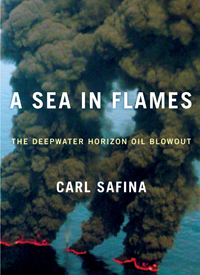
Deepwater Horizon, One Year Later: A Conversation With Carl Safina
(The Atlantic) At approximately 9:50 P.M. on April 20, 2010, a well ruptured at the Macondo 252 site, three miles under the surface of the Gulf of Mexico and 40 miles southeast of the Louisiana coast. The blowout would kill 11 men, destroy the Deepwater Horizon rig, and, 205.8 million gallons of oil later, constitute the largest accidental marine oil spill in the history of the petroleum industry.
A Sea in Flames: The Deepwater Horizon Oil Blowout is conservationist Carl Safina’s impassioned account of the Deepwater Horizon disaster, a tale of industry mismanagement and environmental catastrophe in a region already facing “death by a thousand cuts”.
Flurry of lawsuits filed on anniversary of Deepwater Horizon explosion continues
(Times-Picayune) The wave of lawsuits filed on the one-year anniversary of the Deepwater Horizon explosion and three-month oil gusher continued into Wednesday evening, with BP filing suit against Transocean for $40 billion and other contractors on the ill-fated well making other claims.
In a statement, BP said its claims against Transocean are consistent with the conclusions reached by the Presidential Commission, which found that Transocean missed critical signs that hydrocarbons were flowing up the riser and failed to take appropriate actions to shut down the Macondo well. “But for Transocean’s improper conduct, errors, omissions, and violations of maritime law, there would not have been any blowout of the exploratory well in Mississippi Canyon, Block 252,” the company said. … Earlier in the day, BP had sued Cameron International, calling its blowout preventer faulty. BP also sued Halliburton, saying that its “misconduct” with the cement job on the well contributed to the blowout.
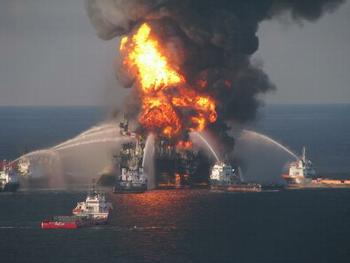
Lest we forget –
April 20, 2011
Kenneth Feinberg: BP Fund Adminstrator
(CBC- The Current) Last June, BP set aside 20-Billion-dollars as compensation for people whose lives were devastated by the oil spill in the Gulf of Mexico.
Now, one year to the day after the blow-out, many of those people want to know why they still haven’t seen the money.
Halliburton sues BP over Deepwater Horizon disaster
… Halliburton says that it contracted with BP Exploration on April 15, 2009, to provide drilling support services in the Gulf of Mexico, including the Macondo oil well, located on the Mississippi Canyon Block 252.
According to the brief, this contract included an indemnity clause which, among other things, released Halliburton Energy Services from all claims, losses, damages, expenses and liabilities arising from blowout, fire, explosion or any uncontrolled well condition resulting in personal injury, wrongful death, pollution and contamination.
19 April
BP oil spill: The environmental impact one year on – good map too.
(BBC) … one year on, what environmental impact did one of world’s largest accidental oil spills have on the region’s wildlife and habitats, and has it been as bad as it was feared at the time?
Scientists have warned that it is too soon to attempt to offer a considered assessment on what impact the Deepwater Horizon oil spill, the largest of its kind, has had on the Gulf of Mexico’s wildlife.
In short, they said, nature did not work in such a way that the full picture will present itself within just one year.
Counting the cost of the BP disaster one year on
(BBC) A year after the explosion on the Deepwater Horizon the cost of the human and environmental disaster is still being counted.
18 April
The Gulf of Mexico’s Seafood Rebirth a Year After the BP Oil Spill
(The Daily Beast) One year after the BP oil disaster, marine life is thriving in the Gulf of Mexico and fishermen and state officials are optimistic about the summer season. But locals still battling health problems are angry at the oil giant’s failure to meet its commitments
14 April
Protesters Disrupt BP’s First Shareholder Meeting Since Oil Spill
(ENS News) Shareholders questioned board members about excessive executive pay and a lack of transparency on safety improvements.
Scuffles, protests mar BP shareholder meeting
(AP) … About 7 percent voted against the re-election of chairman Carl-Henric Svanberg, who has been criticized for his soft response to the spill, and just over 11 percent voted against the company’s remuneration report because of bonuses awarded to Iain Conn, BP’s head of refining and Chief Financial Officer Byron Grote for work not related to the oil spill.
Former CEO Tony Hayward also grabbed headlines with a $17.9 million pension, $1.6 million payoff and about $13 million in share options despite a series of public gaffes that led to his ceding the CEO post to Bob Dudley, the first American to head the London-based company.
3 February
Pressure on Kenneth Feinberg to disclose BP pay deal
(Reuters) Established to compensate victims of the BP Plc oil disaster, it essentially invests one man with full power over how the money is distributed, while he is being paid by the company and unsupervised by any government body.
Now pressure is intensifying for Feinberg to fully disclose his fee arrangement with BP. But interviews with experts in dispute resolution and legal ethics suggest that Feinberg is under no obligation to unveil anything about his deal with BP — and in fact, in a report released last month, he disclosed more than he had to. A Reuters Legal analysis found that Feinberg is operating in a gray area not governed by rules that typically apply to arbitrators or fund administrators.
11 January
Gulf of Mexico oil spill: Panel urges major reforms
(BBC) A major US report into the Gulf of Mexico oil spill has called for wide-ranging reforms of the oil industry to prevent a repeat of the disaster.
The report comes from a US presidential commission investigating the spill.
The panel also said the US needed to expand and update drilling regulation and establish an independent drilling safety agency.

